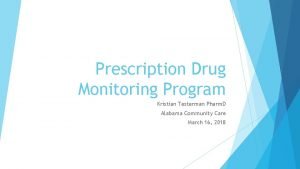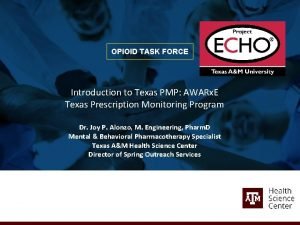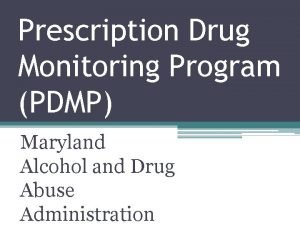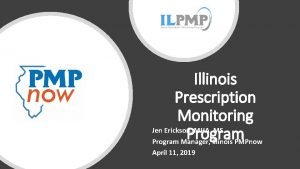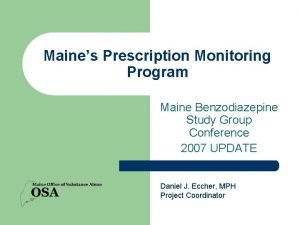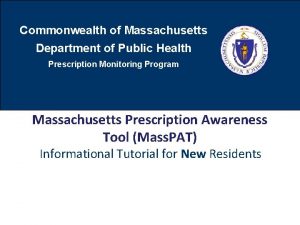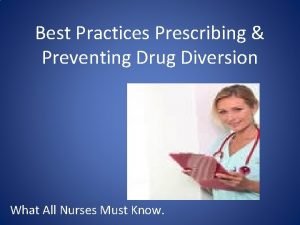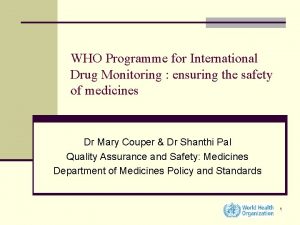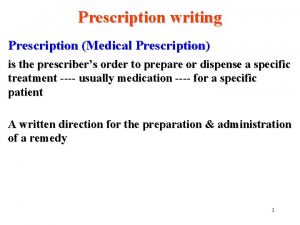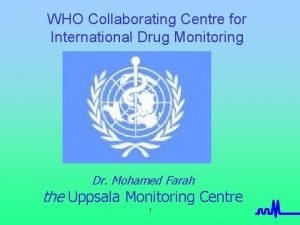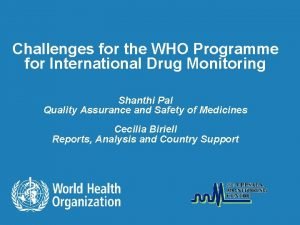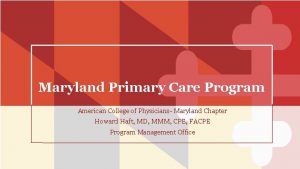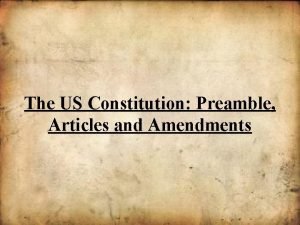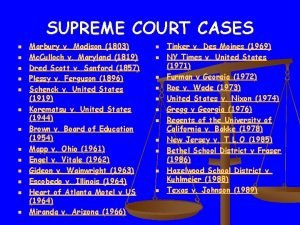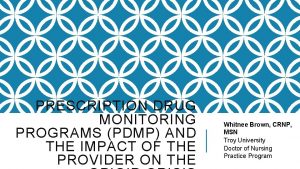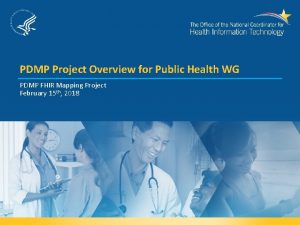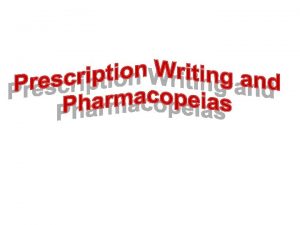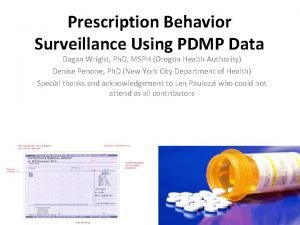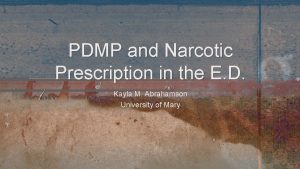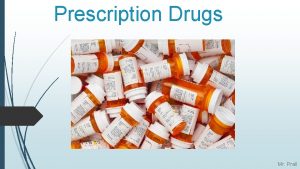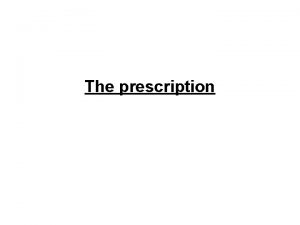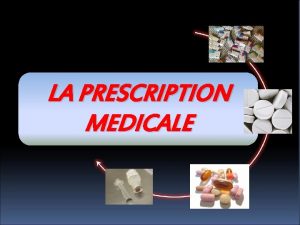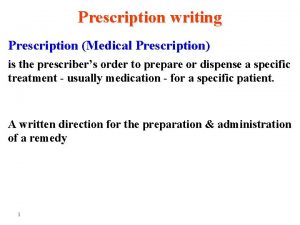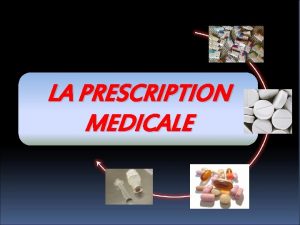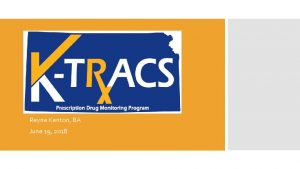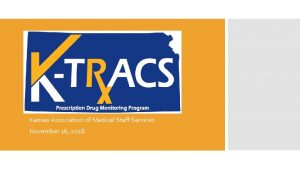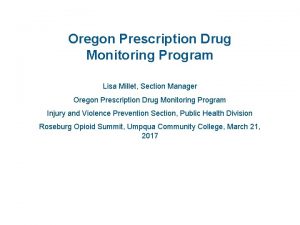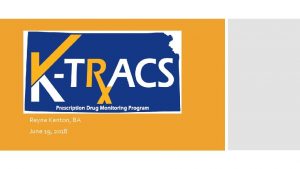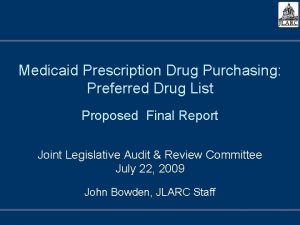Maryland Prescription Drug Monitoring Program PDMP United States
































- Slides: 32

Maryland Prescription Drug Monitoring Program (PDMP)

United States: Injury Deaths by Cause, 1999 -2010 Age adjusted rate per 100, 000 16 14 Poisoning MV Traffic Drug Poisoning 12 10 Firearm 8 6 4 Fall 2 0 2002 2004 Data Source: National Vital Statistics System-Mortality (NVSS-M), CDC/NCHS Slide Source: Maryland Poison Center 2006 2008 2010


United States: Drug Overdose Deaths Among Women, 1999 -2010 7000 400% Increase (265% for men) Number of Deaths 6000 5000 4000 Rx opioids benzodiazepines 3000 antidepressants heroin 2000 cocaine 1000 SOURCE: National Vital Statistics System, 19992010 (deaths include suicides) Year 10 20 09 20 08 20 07 20 06 20 05 20 04 20 03 20 02 20 01 20 00 20 19 99 0


Source: CDC, “Policy Impact: Prescription Painkiller Overdoses” http: //www. cdc. gov/homeandrecreationalsafety/rxbrief/

Prescription Drug Abuse & Overdose in Maryland Between 2008 and 2012: • 42% (1437) of all drug- and alcohol-related overdose deaths involved a Rx opioid analgesic • Rx opioid-related admissions to publicly-funded substance use disorder (SUD) treatment programs increased 116% • Publicly-funded SUD treatment admissions related to oxycodone increased 163%

DHMH Vital Statistics Administration, “Drug and Alcohol Intoxication Deaths in Maryland, 2007 -2012” http: //adaa. dhmh. maryland. gov/Documents/content_documents/Overdose. Prevention/2007 -2012%20 intox%20 report_final. pdf

Admissions to State-Supported Substance Use Disorder Treatment Programs Maryland Alcohol and Drug Abuse Administration Patient Race/Ethnicity & Gender 2012 Hispanic Females Males 1% 1% Black Females 5% Other Males Other 1% Females 1% Black Females 14% Hispanic Other Males Other Females 1% Hispanic 1% Males 3% White Males 30% Black Males 10% White Males 44% White Females 37% Prescription Drug-Related Admissions N = 10, 937 Black Males 35% White Females 15% Other Admissions N = 34, 320

Admissions to State-Supported Substance Use Disorder Treatment Programs Maryland Alcohol and Drug Abuse Administration Patient Age 2012 Over 50 6% 41 to 50 14% 31 to 40 20% Over 50 14. 3% Under 21 15% Under 21 18. 9% 41 to 50 24. 2% 21 to 30 24. 8% 21 to 30 45% 31 to 40 17. 7% Prescription Drug-Related Admissions N = 10, 937 Other Admissions N = 34, 320

PDMP Goals • Assist medical, pharmacy and public health professionals in the identification and prevention of prescription drug abuse • Assist law enforcement and regulatory agencies in the identification and investigation of illegal prescription drug diversion • Promote a balanced use of prescription data that preserves the professional practice of healthcare providers and legitimate patient access to optimal pharmaceutical care

PDMP as a Clinical Tool Give healthcare providers real-time, electronic access at the point-of-care to their patients’ complete Maryland controlled dangerous substances (CDS) prescription history to: • Identify aberrant drug using behavior (e. g. receiving multiple CDS Rx from other providers) • Improve providers’ ability to identify possible substance use disorders and refer to appropriate assessment, treatment and recovery services • Improve providers’ ability to safely and effectively manage patients’ pain and other conditions with CDS pharmacotherapy • Increase confidence in prescribing decisions and patient compliance and decrease potential for harmful drug interactions

What Does the PDMP Do? • Electronic collection of data on Schedule II-V CDS dispensed to patients in Maryland • Secure storage of prescription information • By law, make prescription data available to: q Healthcare providers q Public health regulatory agencies q Law enforcement agencies q Researchers q Patients

PDMP Authority • Legislation in 2011: Md. Ann. Code Health. General Article § 21 -2 A • Regulations in 2012: COMAR 10. 47. 07 • Administered by the Maryland Department of Health and Mental Hygiene (DHMH), Alcohol and Drug Abuse Administration (ADAA)

The Role of CRISP • DHMH has partnered with Chesapeake Regional Information System for our Patients (CRISP) to make CDS prescription data collected by the PDMP available to healthcare providers. • The CRISP health information exchange (HIE) query portal is the only authorized source for provider access to PDMP data. • CRISP provides user registration and technical support services for providers accessing medication history and other clinical information available through the HIE.

How Does the PDMP Work? Within 3 business days of dispensing a CDS Rx drug in Maryland, dispenser must electronically report identifying information for: • Patient for whom drug is prescribed • Prescriber • Dispenser • Drug NOTE: Both pharmacies and dispensing practitioners are required to report

Data Reported by Dispensers Drug & Rx data • • • Rx # Rx date issued Rx date filled Rx new or refill? # refills ordered Payment sources NDC code Quantity dispensed Days’ supply Patient data • • • Name (first, last) Date of Birth Gender Address ID # Prescriber data • DEA # • Last name Dispenser data • DEA #

Reporting Exemptions Direct administration of CDS to a patient Giving a patient drug samples Pharmacies the serve only hospital inpatients Specialty pharmacies that have received a waiver from the Board of Pharmacy to exclusively serve assisted living, comprehensive care and developmental disabilities facilities • Opioid maintenance programs (methadone clinics) • Veterinarian dispensing • Pharmacy dispensing to hospice inpatients (if approved for a waiver by DHMH) • •

Who Can Access PDMP Data? Prescribers • • Healthcare practitioners authorized to prescribe CDS For Maryland-licensed practitioners, must have current federal DEA AND Maryland CDS registration (with DHMH Division of Drug Control) Dispensers • • Pharmacists and practitioners that dispense CDS Note: Pharmacists registering for a “dispenser” account will only be able to access PDMP data through the CRISP HIE Practitioner Delegates • • Prescriber or dispenser may delegate access to a licensed healthcare practitioner who works in their practice Practitioner is not themselves authorized to prescribe or dispense but receives their own user account

Terms of Legitimate Access & Use Prescribers (and licensed healthcare practitioners delegated by a prescriber) may access PDMP data “in connection with the medical care of a patient. ” Dispensers (and licensed healthcare practitioners delegated by a dispenser) may access PDMP data “in connection with the dispensing of a monitored prescription drug. ” NOTE: PDMP data are confidential, privileged, not subject to discovery or subpoena in civil litigation and are not public records

Unlawful Access & Use PDMP Law Criminal Penalties: “A person who knowingly discloses, uses, obtains, or attempts to obtain by fraud or deceit prescription monitoring data in violation of (Health-General Article, § 21 -2 A, Annotated Code of Maryland) shall be guilty of a misdemeanor and on conviction is subject to imprisonment not exceeding 1 year or a fine not exceeding $10, 000 or both. ” Administrative Sanctions: “A prescriber or dispenser who knowingly discloses or uses prescription monitoring data in violation of (Health -General Article, § 21 -2 A, Annotated Code of Maryland) shall be subject to disciplinary action by the appropriate licensing entity.

Re-disclosure of PDMP Data PDMP Law “The release of prescription monitoring data by a prescriber or dispenser to a licensed health care professional solely for treatment purposes in a manner otherwise consistent with State and federal law is not a violation of Health-General Article, § 21 -2 A, Annotated Code of Maryland. ” PDMP Regulations “Redisclosure of prescription monitoring data… is prohibited unless intended to facilitate the treatment of a patient and is consistent with all other State and federal laws and regulations governing the security and confidentiality of protected health information and personal medical records. ”

Caution in Interpreting PDMP Data • Prescription information is reported to the PDMP by the pharmacy or practitioner that dispensed the drug. • Although all efforts are made to ensure data accuracy, reports may contain errors. • If you or your patient has concerns about possible data inaccuracies, first contact the dispenser to verify whether prescription information was reported accurately. The original prescription serves as the official record. • If an error is confirmed by the dispenser, please contact PDMP administration at DHMH ADAA by email at dhmh. pdmp@maryland. gov or call 410 -402 -8686.

Controlled Medication Prescribing: A Balancing Act Appropriate management of specific conditions for which controlled medications may be indicated Balanced by Risks of unintended consequences including addiction and overdose

Key Points on Prescription Medication Abuse • Look for evidence of aberrant drug-taking behaviors, or “red flags” – Early refills – Lost prescriptions – Multiple similar prescriptions from different doctors • Aberrant drug-taking behaviors exist on a spectrum from less serious to more serious • The presence of aberrant drug-taking behaviors does not necessarily equal addiction • Talk to your patients and screen for substance use disorders!

Screening and Brief Intervention and Referral to Treatment (SBIRT) • ASK • ASSESS • ADVISE & ASSIST • ARRANGE FOLLOW-UP For more information on SBIRT, including screening tools, visit http: //www. sbirt. umaryland. edu/sbirt. aspx 26

Referrals 1) To specialized substance use disorder treatment facility 2) To independent addiction specialist a) Addiction medicine specialist b) Addiction psychiatrist c) Licensed non-physician clinician 3) Refer for: a) Addiction assessment b) Addiction treatment as indicated by assessment

Referral Resources • Local Health Department – Behavioral Health or Addiction Services • Maryland Alcohol and Drug Abuse Administration Resource Directory http: //adaa. dhmh. maryland. gov/Site. Pages/ADAAResource. Directory. aspx • CSAT Buprenorphine Prescriber Locator http: //buprenorphine. samhsa. gov/pls/bwns_locator /!provider_search. process_query? alternative=CHOI CEG&one_state=MD

Key Points on Safe Opioid Prescribing • Distinguish between acute versus chronic pain • Conduct a comprehensive pain assessment • Identify patient risk factors for addiction – Family history of any substance use disorder – Personal history of any substance use disorder – Untreated psychiatric disorders • For acute moderate to severe pain: – Prescribe short-acting preparations – Prescribe for short periods of time without refills • For chronic moderate to severe pain: – Add opioids on a trial basis only if non-opioid therapies are ineffective in improving function – Start opioids when potential benefits likely will outweigh the risks – Have patient provide fully informed consent – Set clear and measurable goals to determine effectiveness – Explain to patient upfront when and how opioids might be stopped

Safe Opioid Prescribing Resources • Prescribers’ Clinical Support System for Opioid Therapies: http: //www. pcss-o. org/ • Collaborative for REMS Education: http: //www. core-rems. org/ • VA/Do. D Clinical Practice Guideline: http: //www. healthquality. va. gov/COT_312_SUMer. pdf

Pain and Addiction Resources • American Society for Addiction Medicine: http: //www. asam. org/research-treatment/painand-addiction • National Institute on Drug Abuse (NIDA): Prescription Drugs: Abuse and Addiction http: //www. drugabuse. gov/publications/researchreports/prescription-drugs

Overdose Prevention • New law in Maryland to decrease opioid overdoses (Md. Code Ann. Health Gen § 13 -3101) • Trained lay people can obtain prescriptions for naloxone to counteract opioid overdose • Buys time during overdose until emergency medical services arrive • Consider prescribing naloxone to all patients taking prescription opioids • Naloxone can save lives!
 Alabama prescription drug monitoring program
Alabama prescription drug monitoring program What is a narx score
What is a narx score Pdmp maryland
Pdmp maryland Prescription monitoring program illinois
Prescription monitoring program illinois Maine pmp
Maine pmp Masspat registration
Masspat registration Drug diversion best practices
Drug diversion best practices Who program for international drug monitoring
Who program for international drug monitoring How to write drug prescription
How to write drug prescription Example of crude drug adulterated with exhausted drug
Example of crude drug adulterated with exhausted drug Pull out you've hit an artery
Pull out you've hit an artery Who programme for international drug monitoring
Who programme for international drug monitoring Soar maryland
Soar maryland Ged programs in maryland
Ged programs in maryland Maryland physician health program
Maryland physician health program Mdpcp program
Mdpcp program Maryland motorcycle safety program
Maryland motorcycle safety program Was the united states on the axis powers or allied powers?
Was the united states on the axis powers or allied powers? Mediterranean climate in us
Mediterranean climate in us 36 30 line
36 30 line Nasl
Nasl Marshall case
Marshall case United states student association
United states student association The united states ought to provide a universal basic income
The united states ought to provide a universal basic income Us constitution preamble
Us constitution preamble The united states in the caribbean 1776 to 1985
The united states in the caribbean 1776 to 1985 What is the southeast region of the united states
What is the southeast region of the united states Expansion of the united states of america 1607 to 1853 map
Expansion of the united states of america 1607 to 1853 map How does nicholas novikov describe the united states
How does nicholas novikov describe the united states Oregon country previous owner
Oregon country previous owner Awake united states song
Awake united states song Mapp v. ohio
Mapp v. ohio Why did the united states invade cuba in 1898?
Why did the united states invade cuba in 1898?
